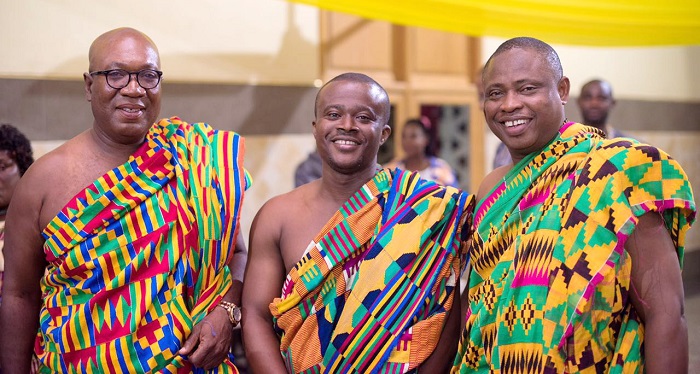Kente traces its Origin from the Ewes
The Definition and Etymology of the word Kente

The Kente cloth is associated with traditional African clothing. The online English dictionary defines Kente as “a type of fabric made of interwoven cloth strips native to Ghana.” Evidently, its usage is widespread in Ghana. The Kente cloth did not originate from the ancient Asante Kingdom as it has been commonly told and widely circulated.
The Kente cloth forms part of the integral part of the Ewe culture even before they settled in their present home. The word Kente is a derivative of the ewe expression ‘Ke na te’ which literarily means ‘open and stick’. The combination of the two verbs (Ke-te) forms a name for this cloth type in the Ewe-Anlo dialect which depicts the method of weaving the fabric from the loom. Kete was first written as ‘Kente’ upon the advent of the Europeans. Though the Agortime people also have a rich culture and history about this fabric, they preferably call it ‘Agbamevor’ to wit “cloth from the loom”.
- Advertisement -
The kente cloth has nothing to do with baskets (‘Kent3n’ in Akan) as the Ashanti’s rendition seem to push down our throats. Another version of the Ashante’s origin of kente in Ghana makes mention of two folkloric characters who went hunting and chanced on a spider spinning a web. They learnt how the spider was building the web and voilà, kente came into being. I have no intention to doubt the ingenuity of the Asantes to create folklores. But to set the records straight, kente is written from ‘Kete’ –two ewe verbs which directly describes how the kente cloth is made in the loom- called ‘agbati’ in Ewe.
- Advertisement -
The Making, Uses and Trade of Kente in Eweland before Independence
According to oral history, the early Ewe migrants used to keep cotton seeds in their reed woven bags known as ‘kevi’ in the Ewe language. Whenever they settled at a place for a period of time, they planted the seeds to get cotton wool. This wool is harvested, spun to weave the ‘Ketevor’ –kente cloth. This method of kente making was in used for hundreds of years till I was born in 1932 to witness. I can vividly remember how in those days my father and his brothers use to spin cotton wool to make yarns for weaving. This method however ended through development of new ideas and machine methods of making yarns and threads.
The Ewes continue their craftsmanship in the kente cloth making in their settled-present-day home. They traded same with the new-contact-seaborne Europeans. Their first trading partners were the Danish and Portuguese along the coast especially in present-day Togo before the Germans colonised that land. The first major Kente Market was in Lomé (the capital of Togo) known as Asigame, which place is now a lorry station.
When the first World War ended in 1919 Togo, being a German colony, was greatly affected due to her colonial master’s defeat. The kente market was thus moved to Keta behind Fort Prinzenstein, as Keta was within a British colony. It was situated there till I was while schooling in the 1940s. Presently, the Kente Market is located in Agbozume in the Ketu South District. The Keta Kente Market was relocated to Agbozume in the 1960s due to heavy rain flooding at the time (mind you, the Agbozume (Somey) people are from Keta).
My father (of blessed memory) being a very good Kente weaver himself told us (his children) an interesting story: “Once upon a time at the Keta Kente Market, to the surprise of all, the District Commissioner (DC) came to the market with his officials accompanied by police officers. The market stood still with deaf silence. Going through the market, inspecting some kente cloths, the DC asked some three specific weavers to follow him to the Fort –the official government residence”. Among the three weavers invited was my father. Each of them were given two different designs to weave in a month. The other two were from Kpetoe and Afiadenyigba. As if by competition, these weavers finished their tasks in record time –no doubt they were all mastercraftmen.
In the midst of warm welcome and entertainment some months later upon another invitation by the Commissioner to the Fort, the news was broken to the three weavers with congratulations for being the best Kente weavers in the Gold Coast. Upon receipt of cash prizes and gifts in testimony of such a feat, they were told their Kente cloths have been presented to the Prince of Wales. Incidentally, two Keta chiefs who were invited to meet the Prince of Wales were adorned in Kente apparels whiles other native chiefs, i.e. the Akan chiefs, were in velvet-like adinkra clothes. These are events that actually happened with pictures taken not folktales as we are been told elsewhere.
It is remarkable to note here how significantly the Kente Cloth (Ketevor) featured in everyday life in traditional Ewe culture. Though space might not allow me, I would like very much to mention but a new.
- In the olden days, the Kente cloth was used as an ‘ambulancce’. Because of its strong texture, it was used to convey the ill or seriously injured to seek medical attention. The same was also used as a ‘hearse’ to convey corpses from one place to the other. Selected people were known as the ‘crew’ of these practices and used Kente in those days for these purposes.
- The Ewes wrapped their dead in Kente clothes (in the absence of a coffin) for public viewing before burial.
- During naming ceremonies in Eweland, the new born is always wrapped in Kente material before been out-doored. Thereafter, it is the Kente cloth that is used to carry the baby at the back throughout childhood.
- The Kente cloth is a very important item on an Ewe ‘marriage list’ which is inspected carefully.
- Finally, there are a lot more uses of the Kente cloth but to put it in a nut shell, Kente reflects in all life cycle in the Ewe culture: from birth, through marriage to death.
Kente: A National Symbol at Independence Celebrations and Beyond
During the clamour for independence in the 1950s, a special delegation was set up to meet the Colonial Government Officials and make a strong case for Self-Rule. A member of that delegation, Mr K.A. Busia (accompanied by purchasing agents) was sent to The Keta Kente Market to buy Kente as an evidential material of some of the things we can do for ourselves by ourselves: “if we can manufacture our own clothes, then we are matured enough to rule ourselves” was the message at the time. Mr. K.A. Busia was escorted (shown around) by Mr. Akpalu alias Home boy, who later became Member of Parliament for Keta.
More so, during the first independence celebration of 1957, there was The National Exhibition for Regional Art Collections on display for the Royal House officials at the Ridge Park (now called the Afua Southerland Childern’s Park). There were only five regions by then, (Western, Eastern, Volta, Ashanti and Northern) for the records only the Volta Region displayed their cultural kente cloth to the Royal delegation. They very much admired the cloths for the people’s rich culture and craftsmanship.
- Advertisement -
Right after independence, there were two kente weavers’ exhibition. The two consecutive events were won by weavers from Hohoe and Kpetoe in the Volta region. One of these weavers is believed to have made the kente don by Dr. Kwame Nkrumah on his wedding day nicknamed “Fathia fata Nkrumah” viz Fathia fits Nkrumah.
At the same time, Miss Monica Amekoafia, The First National Beauty Queen (needless to say an Ewe whose contestant number was 9) was adorned with rich Ewe kente clothes during the contest.
All these are historical facts pointing to the testament that predominantly, the Kente cloth was showcased and displayed commonly and mainly by the Ewes.
Politicisation of Kente
Politically, Dr. Kwame Nkrumah, who wore kente on jumper during his inaugural ceremony, took lead in the wearing of kente in the National Assembly more than any other MP. Notably Messrs. K.A. Gbedema and M. Apkalu wore kente to parliament and other national events.
Because of its already widespread usage in Ghana, anyone wearing kente anywhere around the world is identified as a Ghanaian or a friend to Ghana. I am quite aware there were attempts in earlier parliaments to pass an act (make a law) declaring kente cloth as a national clothing. This brought about the scramble of the origin of the kente cloth in Ghana. As Dr. George Grande cleverly remarked during the Agotime Kente Festival Launch in 2015. “kente in this country had been highly politicised and evoked emotions”. He noted that historians who tried to extrapolate and reconstruct the history of the evolution of Kente in the country had created more confusion (Daily Graphic 25/08/2015, pp23)
Fabricated Stories and Folktales about Kente
Scott Fitzgerald once said “you don’t write because you want to say something, you write because you have something to say”. In the Daily Graphic of 21st December 2019 edition page 13, a featured story narrating the history of Kente quoted Nana Bodzie Ansah II, Chief of Bonwire give a folkloric account of the origin of kente where “two Ashanti brothers went hunting one afternoon and came across a spider making a web. According to the story, “they studied the spider and its art of creating the web to start a design which had lived and survived for almost 400 years”. This is both interesting and ridiculous!
I would like to state crystal clear here again: the kente cloth is never cobwebs –a product of spiders. Kente clothes (kete-vor) was born out human ingenuity and creativity as a product of a woven material with yarn spinning through cotton wool in the olden days. The spider web or cobwebs is for catching insects for the spider, it bears no resemblance to kente weaving, truly speaking. May I ask, was the spider having any weaving apparatus (a loom) for men to learn kente weaving from it? The spider who they claim to be their teacher is an arachnid with eight legs that spins webs in order to catch insects. If an insect spins a web it produces from its own body, that’s the Lord’s doing.
Conclusion
In conclusion, I am only trying to help the public and future generations to understand much of which we may be ignorant about. The good Book teaches us that we are to study-not argue, not to refute, but to show ourselves approved unto God-to learn God’s will. There is no gainsaying that in recent years so much valuable work has been done in adding more and more value to the kente fabric to be befitting as a national dress. This has no doubt made the kente material more an iconic model to be emulated by all and future generations of Ghana and the world at large. All contributing factors and people should be duly acknowledged most especially, its originators –the Ewe people –should not be painted black and forgotten.
Mr. Godwin Kudzo-Norsah
Private Citizen.
+233546070783
- Advertisement -



